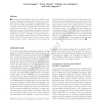Free Online Productivity Tools
i2Speak
i2Symbol
i2OCR
iTex2Img
iWeb2Print
iWeb2Shot
i2Type
iPdf2Split
iPdf2Merge
i2Bopomofo
i2Arabic
i2Style
i2Image
i2PDF
iLatex2Rtf
Sci2ools
JOCN
2010
2010
Coercion and Compositionality
■ Research in psycholinguistics and in the cognitive neuroscience of language has suggested that semantic and syntactic integration are associated with different neurophysiologic correlates, such as the N400 and the P600 in the ERPs. However, only a handful of studies have investigated the neural basis of the syntax–semantics interface, and even fewer experiments have dealt with the cases in which semantic composition can proceed independently of the syntax. Here we looked into one such case— complement coercion—using ERPs. We compared sentences such as, “The journalist wrote the article” with “The journalist began the article.” The second sentence seems to involve a silent semantic element, which is expressed in the first sentence by the head of the VP “wrote the article.” The second type of construction may therefore require the reader to infer or recover from memory a richer event sense of the VP “began the article,” such as began writing the article, and to...
| Added | 28 Jan 2011 |
| Updated | 28 Jan 2011 |
| Type | Journal |
| Year | 2010 |
| Where | JOCN |
| Authors | Giosuè Baggio, Travis Choma, Michiel van Lambalgen, Peter Hagoort |
Comments (0)

